#credit to hubble space telescope
Text
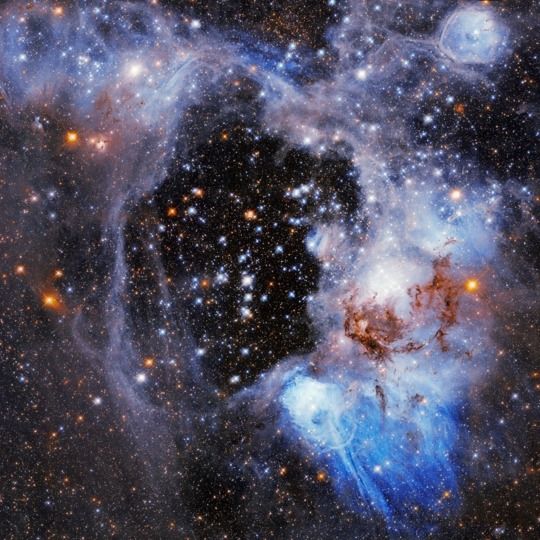

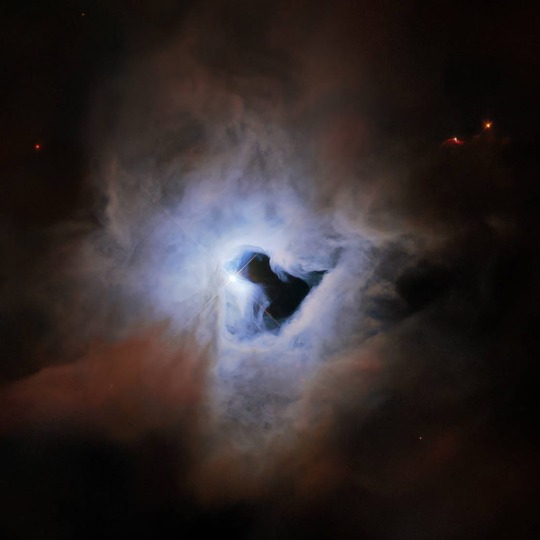
Gojo's eyes are either N44 or NGC 1999
5 notes
·
View notes
Text
The celestial object of the day is the Water Lily Nebula!
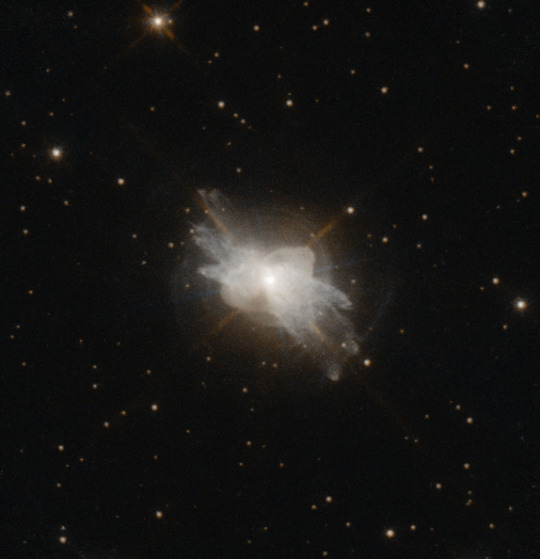

This pre-planetary nebula (the phase before becoming a planetary nebula) has been discovered to have organic hydrocarbons that constitute the base for life!
#First image credit: Judy Schmidt#Second image credit: NASA/ESA#This post was not planned#I actually intended to post a black hole#But Nebulae are cool idk#astronomy facts#astronomy#astrophotography#outer space#science#space#hubble space telescope#nasa photos#nasa#nasa science#esa#space exploration#hubble telescope#nebula#nebulae#Water lily nebula
49 notes
·
View notes
Text

This is the first image of Saturn's ultraviolet aurora taken by the Space Telescope Imaging Spectrograph (STIS) on board the Hubble Space Telescope in October 1997, when Saturn was a distance of 1.3 billion kilometers from Earth.
Image Credit: NASA/JPL/STScI
4K notes
·
View notes
Text
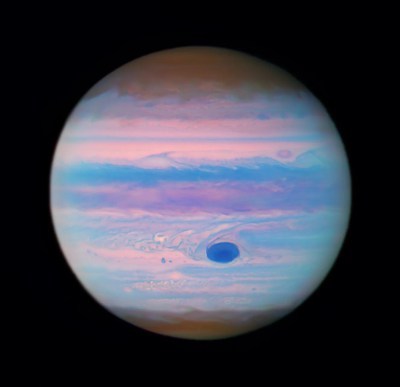
0 notes
Text
NASA Inspires Your Crafty Creations for World Embroidery Day
It’s amazing what you can do with a little needle and thread! For #WorldEmbroideryDay, we asked what NASA imagery inspired you. You responded with a variety of embroidered creations, highlighting our different areas of study.
Here’s what we found:
Webb’s Carina Nebula
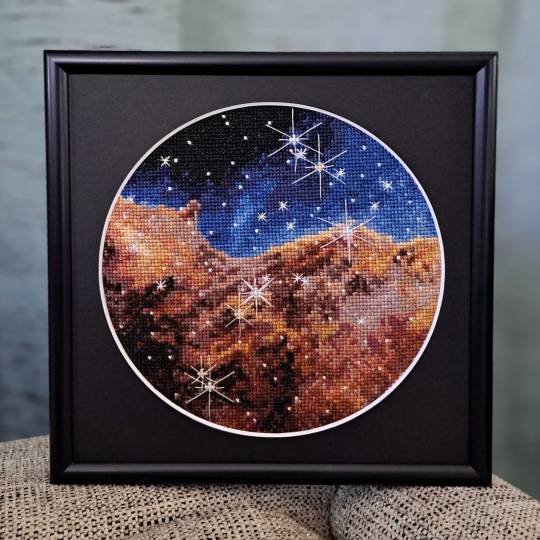
Wendy Edwards, a project coordinator with Earth Science Data Systems at NASA, created this embroidered piece inspired by Webb’s Carina Nebula image. Captured in infrared light, this image revealed for the first time previously invisible areas of star birth. Credit: Wendy Edwards, NASA. Pattern credit: Clare Bray, Climbing Goat Designs
Wendy Edwards, a project coordinator with Earth Science Data Systems at NASA, first learned cross stitch in middle school where she had to pick rotating electives and cross stitch/embroidery was one of the options. “When I look up to the stars and think about how incredibly, incomprehensibly big it is out there in the universe, I’m reminded that the universe isn’t ‘out there’ at all. We’re in it,” she said. Her latest piece focused on Webb’s image release of the Carina Nebula. The image showcased the telescope’s ability to peer through cosmic dust, shedding new light on how stars form.
Ocean Color Imagery: Exploring the North Caspian Sea
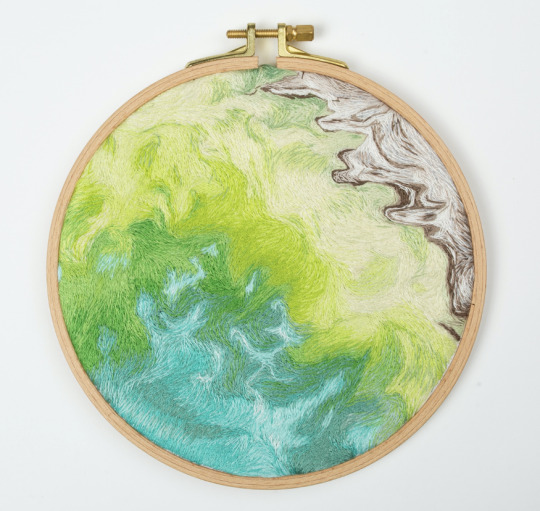
Danielle Currie of Satellite Stitches created a piece inspired by the Caspian Sea, taken by NASA’s ocean color satellites. Credit: Danielle Currie/Satellite Stitches
Danielle Currie is an environmental professional who resides in New Brunswick, Canada. She began embroidering at the beginning of the Covid-19 pandemic as a hobby to take her mind off the stress of the unknown. Danielle’s piece is titled “46.69, 50.43,” named after the coordinates of the area of the northern Caspian Sea captured by LandSat8 in 2019.

An image of the Caspian Sea captured by Landsat 8 in 2019. Credit: NASA
Two Hubble Images of the Pillars of Creation, 1995 and 2015
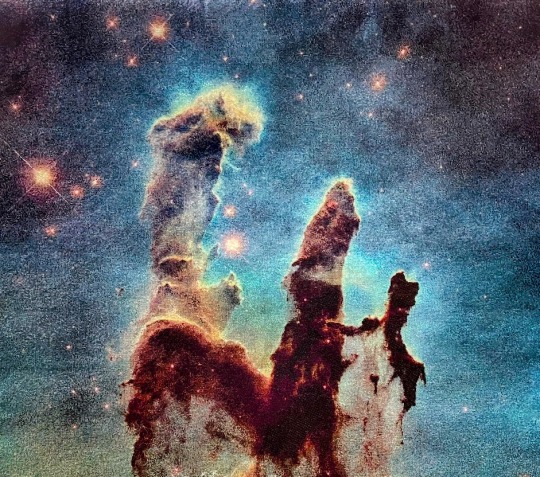
Melissa Cole of Star Stuff Stitching created an embroidery piece based on the Hubble image Pillars of Creation released in 1995. Credit: Melissa Cole, Star Stuff Stitching
Melissa Cole is an award-winning fiber artist from Philadelphia, PA, USA, inspired by the beauty and vastness of the universe. They began creating their own cross stitch patterns at 14, while living with their grandparents in rural Michigan, using colored pencils and graph paper. The Pillars of Creation (Eagle Nebula, M16), released by the Hubble Telescope in 1995 when Melissa was just 11 years old, captured the imagination of a young person in a rural, religious setting, with limited access to science education.

Lauren Wright Vartanian of the shop Neurons and Nebulas created this piece inspired by the Hubble Space Telescope’s 2015 25th anniversary re-capture of the Pillars of Creation. Credit: Lauren Wright Vartanian, Neurons and Nebulas
Lauren Wright Vartanian of Guelph, Ontario Canada considers herself a huge space nerd. She’s a multidisciplinary artist who took up hand sewing after the birth of her daughter. She’s currently working on the illustrations for a science themed alphabet book, made entirely out of textile art. It is being published by Firefly Books and comes out in the fall of 2024. Lauren said she was enamored by the original Pillars image released by Hubble in 1995. When Hubble released a higher resolution capture in 2015, she fell in love even further! This is her tribute to those well-known images.
James Webb Telescope Captures Pillars of Creation

Darci Lenker of Darci Lenker Art, created a rectangular version of Webb’s Pillars of Creation. Credit: Darci Lenker of Darci Lenker Art
Darci Lenker of Norman, Oklahoma started embroidery in college more than 20 years ago, but mainly only used it as an embellishment for her other fiber works. In 2015, she started a daily embroidery project where she planned to do one one-inch circle of embroidery every day for a year. She did a collection of miniature thread painted galaxies and nebulas for Science Museum Oklahoma in 2019. Lenker said she had previously embroidered the Hubble Telescope’s image of Pillars of Creation and was excited to see the new Webb Telescope image of the same thing. Lenker could not wait to stitch the same piece with bolder, more vivid colors.
Milky Way

Darci Lenker of Darci Lenker Art was inspired by NASA’s imaging of the Milky Way Galaxy. Credit: Darci Lenker
In this piece, Lenker became inspired by the Milky Way Galaxy, which is organized into spiral arms of giant stars that illuminate interstellar gas and dust. The Sun is in a finger called the Orion Spur.
The Cosmic Microwave Background
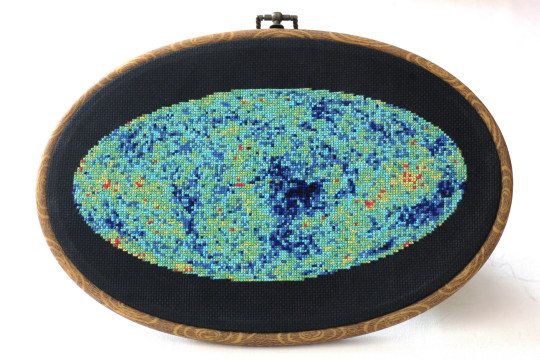
This image shows an embroidery design based on the cosmic microwave background, created by Jessica Campbell, who runs Astrostitches. Inside a tan wooden frame, a colorful oval is stitched onto a black background in shades of blue, green, yellow, and a little bit of red. Credit: Jessica Campbell/ Astrostitches
Jessica Campbell obtained her PhD in astrophysics from the University of Toronto studying interstellar dust and magnetic fields in the Milky Way Galaxy. Jessica promptly taught herself how to cross-stitch in March 2020 and has since enjoyed turning astronomical observations into realistic cross-stitches. Her piece was inspired by the cosmic microwave background, which displays the oldest light in the universe.

The full-sky image of the temperature fluctuations (shown as color differences) in the cosmic microwave background, made from nine years of WMAP observations. These are the seeds of galaxies, from a time when the universe was under 400,000 years old. Credit: NASA/WMAP Science Team
GISSTEMP: NASA’s Yearly Temperature Release

Katy Mersmann, a NASA social media specialist, created this embroidered piece based on NASA’s Goddard Institute for Space Studies (GISS) global annual temperature record. Earth’s average surface temperature in 2020 tied with 2016 as the warmest year on record. Credit: Katy Mersmann, NASA
Katy Mersmann is a social media specialist at NASA’s Goddard Space Flight Center in Greenbelt, Md. She started embroidering when she was in graduate school. Many of her pieces are inspired by her work as a communicator. With climate data in particular, she was inspired by the researchers who are doing the work to understand how the planet is changing. The GISTEMP piece above is based on a data visualization of 2020 global temperature anomalies, still currently tied for the warmest year on record.
In addition to embroidery, NASA continues to inspire art in all forms. Check out other creative takes with Landsat Crafts and the James Webb Space telescope public art gallery.
Make sure to follow us on Tumblr for your regular dose of space!
#NASA#creativity#fiber art#embroidery#art#art challenge#needlework#crafts#handmade#textile art#cross stitch#stitching#inspiration#inspo#Earth#Earth science#Hubble#James Webb Space Telescope#climate change#water#nebula#stars
6K notes
·
View notes
Text

Hoag’s Object, a nearly perfect “ring galaxy” captured by the Hubble Space Telescope (Credit: NASA)
2K notes
·
View notes
Text

The magnificent central bar of NGC 2217 (also known as AM 0619-271) shines bright in the constellation of Canis Major (The Greater Dog), in this image taken by the NASA/ESA Hubble Space Telescope. Roughly 65 million light-years from Earth, this barred spiral galaxy is a similar size to our Milky Way at 100,000 light-years across.
Image Credit: ESA/Hubble & NASA, J. DalcantonA
479 notes
·
View notes
Text
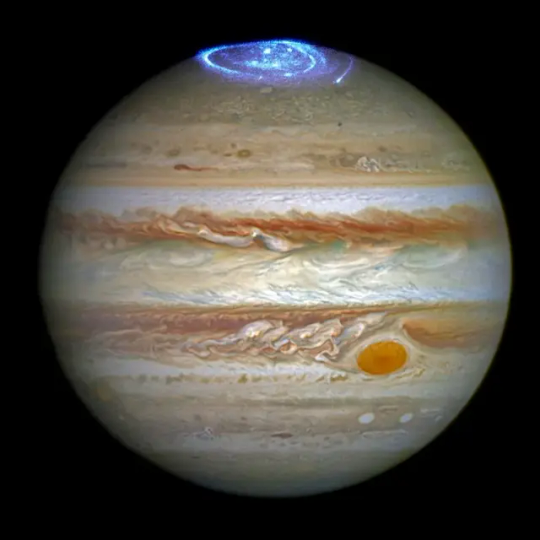
Jupiter’s Aurora
Jupiter's auroras are spectacular natural light displays that occur at the planet's poles, similar to the auroras seen on Earth.
The auroras were photographed during a series of Hubble Space Telescope
Credit: NASA, ESA, and J. Nichols (University of Leicester);
Acknowledgment: A. Simon (NASA/GSFC) and the OPAL team
#jupiter#aurora#space#cosmos#nasa#astronomy#universe#outer space#space exploration#space science#aesthetic#hubble#planets
182 notes
·
View notes
Text

Sometimes, massive stars can blow bubbles. This image shows perhaps the most famous star-bubbles of all, NGC 7635, also known simply as The Bubble Nebula. Although it looks delicate, the 7-light-year diameter bubble offers evidence of violent processes at work. To the top left of the Bubble's center is a hot, O-type star, several hundred thousand times more luminous and 45-times more massive than the Sun. A fierce stellar wind and intense radiation from that star has blasted out the structure of glowing gas in a surrounding molecular cloud. The intriguing Bubble Nebula and associated cloud complex lie 7,100 light-years away toward the boastful constellation Cassiopeia. This sharp, tantalizing view of the cosmic bubble is a reprocessed composite of previously acquired Hubble Space Telescope image data.
Image Credit & Copyright: NASA/ESA/HUBBLE SPACE TELESCOPE
#astronomy#space#science#universe#nebula#bubble#Hubble#Hubble bubble#bubble nebula#light years#far#gas#giant star#star#radiation#Cassiopeia#constellation#follow#like#reblog#the first star#the first starr#thefirststar#thefirststarr#nasa#apod#tumblr#blog#space blog#space blogger
148 notes
·
View notes
Text
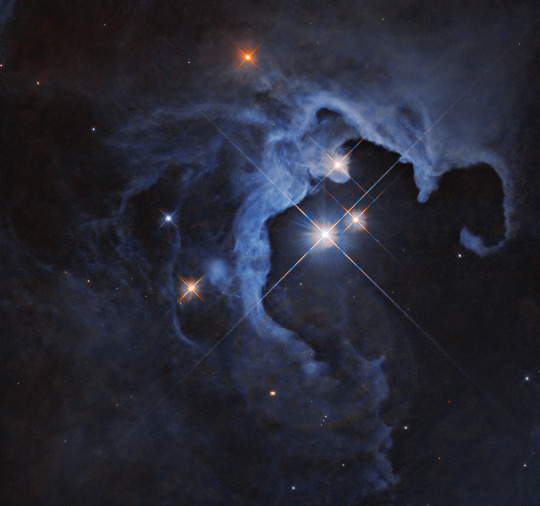
Hubble Views the Dawn of a Sun-like Star | Hubble Space Telescope
Looking like a glittering cosmic geode, a trio of dazzling stars blaze from the hollowed-out cavity of a reflection nebula in this new image from NASA’s Hubble Space Telescope. The triple-star system is made up of the variable star HP Tau, HP Tau G2, and HP Tau G3. HP Tau is known as a T Tauri star, a type of young variable star that hasn’t begun nuclear fusion yet but is beginning to evolve into a hydrogen-fueled star similar to our Sun. T Tauri stars tend to be younger than 10 million years old ― in comparison, our Sun is around 4.6 billion years old ― and are often found still swaddled in the clouds of dust and gas from which they formed. As with all variable stars, HP Tau’s brightness changes over time. T Tauri stars are known to have both periodic and random fluctuations in brightness. The random variations may be due to the chaotic nature of a developing young star, such as instabilities in the accretion disk of dust and gas around the star, material from that disk falling onto the star and being consumed, and flares on the star’s surface. The periodic changes may be due to giant sunspots rotating in and out of view. Curving around the stars, a cloud of gas and dust shines with their reflected light. Reflection nebulae do not emit visible light of their own, but shine as the light from nearby stars bounces off the gas and dust, like fog illuminated by the glow of a car’s headlights. HP Tau is located approximately 550 light-years away in the constellation Taurus. Hubble studied HP Tau as part of an investigation into protoplanetary disks, the disks of material around stars that coalesce into planets over millions of years.
Credits : NASA, ESA, G. Duchene (Université de Grenoble I); Image Processing: Gladys Kober (NASA/Catholic University of America)
#astronomy#NASA#space#hubble space telescope#stars#ESA#Taurus#star#nebula#HP Tau#cosmic dust#light#fav#ref#interstellar#triple-star system#galaxy
148 notes
·
View notes
Photo
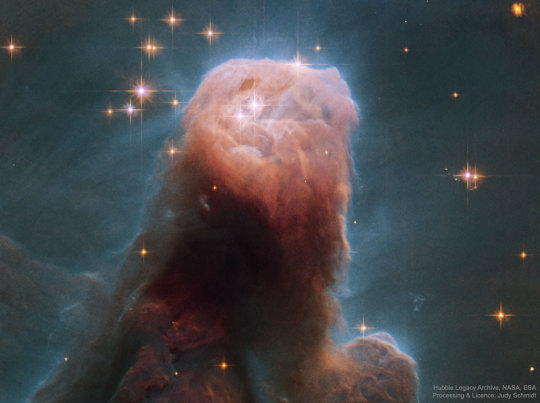
2024 February 4
The Cone Nebula from Hubble
Image Credit: Hubble Legacy Archive, NASA, ESA - Processing & Licence: Judy Schmidt
Explanation: Stars are forming in the gigantic dust pillar called the Cone Nebula. Cones, pillars, and majestic flowing shapes abound in stellar nurseries where natal clouds of gas and dust are buffeted by energetic winds from newborn stars. The Cone Nebula, a well-known example, lies within the bright galactic star-forming region NGC 2264. The Cone was captured in unprecedented detail in this close-up composite of several observations from the Earth-orbiting Hubble Space Telescope. While the Cone Nebula, about 2,500 light-years away in Monoceros, is around 7 light-years long, the region pictured here surrounding the cone's blunted head is a mere 2.5 light-years across. In our neck of the galaxy that distance is just over half way from our Sun to its nearest stellar neighbors in the Alpha Centauri star system. The massive star NGC 2264 IRS, seen by Hubble's infrared camera in 1997, is the likely source of the wind sculpting the Cone Nebula and lies off the top of the image. The Cone Nebula's reddish veil is produced by dust and glowing hydrogen gas.
∞ Source: apod.nasa.gov/apod/ap240204.html
211 notes
·
View notes
Photo

The Infrared Visible Andromeda
Credits: SubaruTelescope, NAOJ, Hubble SpaceTelescope, KPNO, NOAO, Digitized SkySurvey, Spitzer Space Telescope, Robert Gendler
319 notes
·
View notes
Text
The celestial object of the day is M13 or Hercules globular cluster!


The Arecibo message targeted this cluster, conveying encoded details about humanity. Within it, "blue stragglers," massive old and blue stars resulting from collisions within the cluster, can be found.
#First image credit: ESA/Hubble and NASA#Second image credit: Leach and Adam Block Mt. Lemmon#Blue stragglers are interesting#They shine just like a star at the start of its life but are actually in the verge of dying#Reminder to investigate more!!#astronomy#astrophotography#space photography#outer space#space#hubble space telescope#science#space exploration#nasa#nasa photos#astronomy facts#Stellar cluster#globular cluster#Hercules globular cluster#M13#Messier 13
29 notes
·
View notes
Text
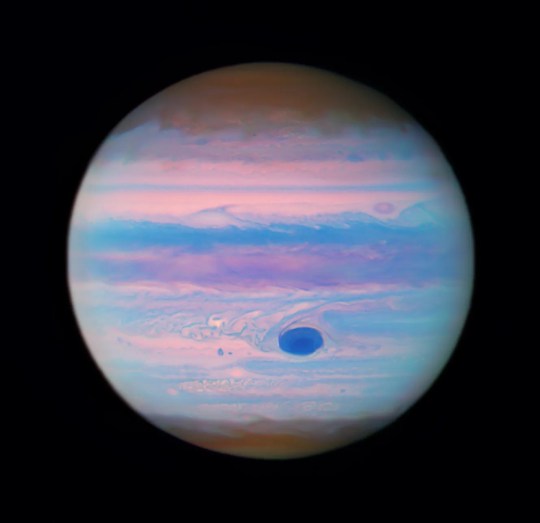
NASA's Hubble Space Telescope reveals an ultraviolet view of Jupiter.
Image Credit: NASA
7K notes
·
View notes
Text
The star colors look different once you get outside the Earth’s atmosphere. From Earth, most stars appear white or bluish because they are too dim for the human eye to perceive color. So, many people assume photographs taken from Hubble or other space telescopes are colorized. In reality, stars really are much more vibrant and colorful than what we see at night.
We see our Sun as yellow but in reality it is more white than yellow.
Check out @scienceisdope for more science and daily facts.
Video credit: unknown (please DM me if you know/are the creator)
634 notes
·
View notes
